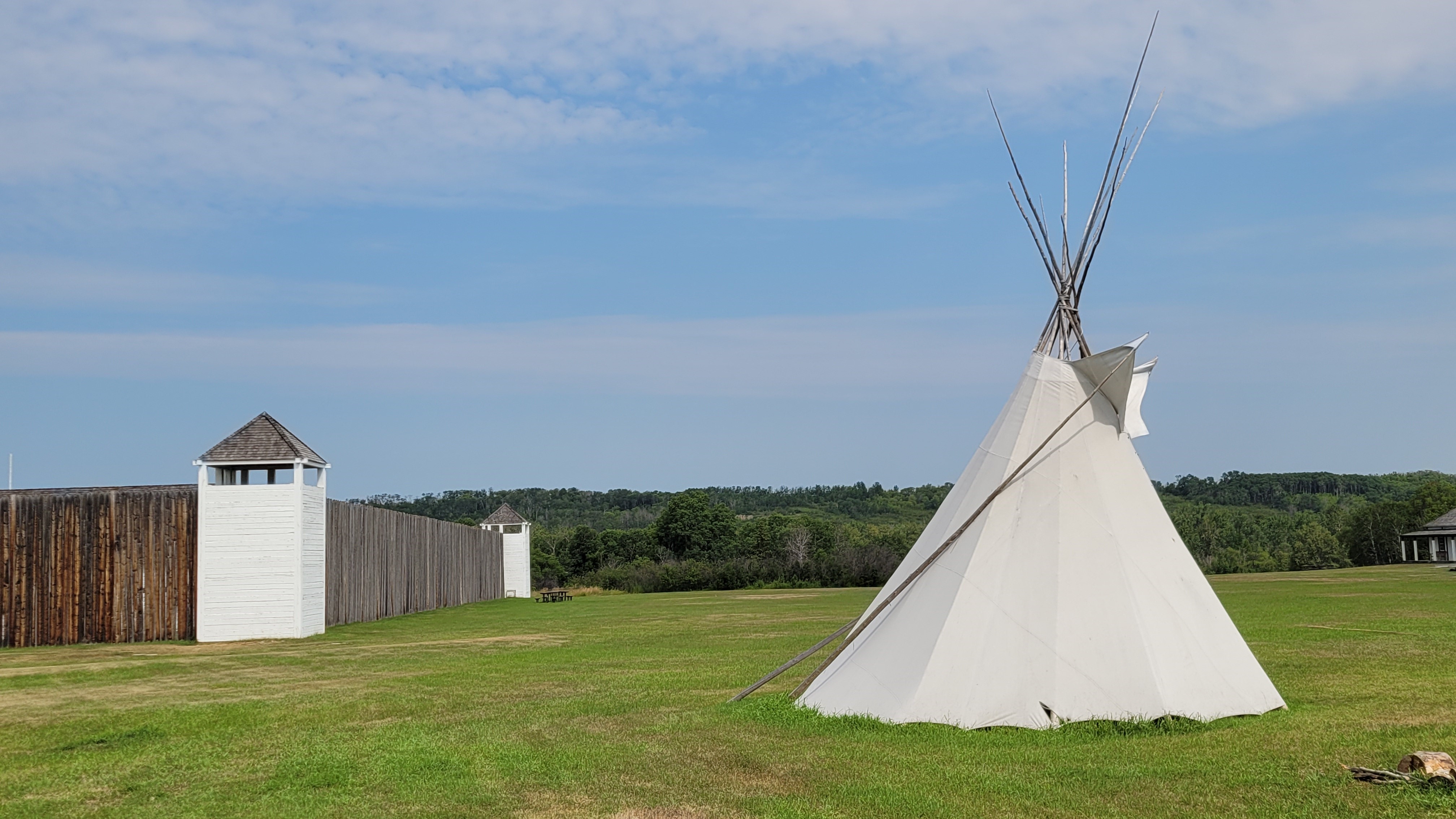Doctrines & Discoveries: Fort Carlton
A visit with Amy Seesequasis

About an hour north of Saskatoon is Fort Carlton Provincial Park, with its reconstruction of the Hudson Bay Company fort that stood there from 1810-1885. This was the site of the original negotiations for Treaty 6. Amy Seesequasis reflects on the Treaty process of 1876, and its implications for today’s residents of Treaty 6 territory, focused through the experience of her own people’s leader, Chief Beardy.
“Go Deeper” guide
Here are travel directions for your own learning tour to the site, along with some helpful background, questions for reflection or group conversation, and suggestions for next steps in your learning journey.
The park is accessible from either Hwy 11 (through Rosthern) or 12 (past Waldheim—a slightly shorter route from Saskatoon). Head onto Hwy 312 and follow the signs to the park (turning north at Eigenheim Church; 20 km/12 miles on gravel road). The Beardy’s cairn is 1.6 km / 1 mile before the park entrance. Note: a Saskatchewan Provincial Park pass is required to enter the park.
Click for map (link opens new window).
Episode glossary
Iron Alliance: political and military treaty negotiated in 1816 between the Cree, Saulteaux (“SOH-toh”, aka Plains Ojibwe, Nakawê), Stoney, and Métis nations.
• kohkom: Cree (and Michif) for grandmother
Cree treaty principles:
• wāhkōhtowin –kinship, treating each other as family [wah-KOH-toe-win]
• wīcēhtowin – honouring and respecting each another [wee-CHAY-toe-win]
• wītaskīwin –sharing the land [wee-TASK-ee-win]
• pimātisiwin – having a good life [pih-MAT-si-win]
• Treaty 6 negotiators
• signatory: one who signs a Treaty document
• Cree leaders from region surrounding Fort Carlton included chiefs Beardy (Kamīyistowesit), Ahtahkakoop, Mistawasis, One Arrow (Kāpeyakwāskonam).
• Crown representative: Alexander Morris, Lieutenant Governor of the North-West Territories (1872-76) and Manitoba (1873-77).
• Treaty clauses
• annuity clause: an agreement “to pay each Indian person the sum of Five Dollars per head yearly”. (That amount has not increased since 1876.)
• the following two clauses were first included with Treaty 6, and added retroactively to previous treaties as well as included in subsequent treaties:
• “medicine chest” clause: an agreement for the Crown to provide appropriate and adequate healthcare on reserve.
• “famine and pestilence assistance” clause: insisted upon at the negotiating table by Poundmaker, it promised relief in case of famine or epidemic. (By 1876, it was evident to all that the buffalo economy had virtually collapsed.)
• Treaty Land Sharing Network – a recent initiative of non-Indigenous landholders to make their lands available for traditional, Indigenous land use activities as envisioned by the Treaties. Begun in Saskatchewan in 2019, it is expanding into neighbouring provinces. (Click for more info.)
- When did you first learn about treaties, and what did you know? How have you grown or changed in your understanding of treaty?
- If you live in a territory governed by treaty (or if you don’t), how does that shape your understanding of your role as an inhabitant of that particular land?
- What do you think of Amy Seesequasis’s comments of how to lean into being “treaty people”?
- How might you make the land itself, and sharing the land, more central to your way of life?
After listening, please sign our online guest register & feedback form.
• read:
o Harold Cardinal & Walter Hildebrandt. Treaty Elders of Saskatchewan. (University of
Calgary Press, 2000).*
o Tasha Hubbard & Marilyn Poitras, editors. The Land is Everything: Treaty Land Entitlement.
(Office of the Treaty Commissioner, 2014).*
o Harold R. Johnson. Two Families: Treaties and Government. (UBC Press, 2007).
*available from the Office of the Treaty Commissioner, www.otc.ca.
• visit:
o Fort Carlton Provincial Park, and the Beardy’s Treaty Cairn near the park entrance.
o Duck Lake Interpretive Centre, Duck Lake, SK
• do:
o explore and support Pêmiska Tourism (an initiative of Beardy’s and Okemasis Cree Nation’s economic development): stay in the Lodges at Fort Carlton, and take in some of the cultural, recreational, and/or culinary offerings: www.pemiska.ca.
o attend the Beardy’s and Okemasis annual powwow (late August) or any other powwow where you live.
Doctrines & Discoveries is a production of MCC Saskatchewan’s Indigenous Neighbours program.
We are deeply grateful for the knowledge keepers who shared their stories, knowledge and insights with us. Proper protocol was followed for the sharing of these truths.
We are grateful to the elders and staff of the Saskatchewan Indigenous Culture Centre for their visionary work in establishing the Buffalo Child Stone interpretive site. www.sicc.sk.ca/buffalo-child-stone
Thanks to the following music artists. Their tracks are used under the Creative Commons licence:
- The opening loop is “Funky Percussions” (loop ver.1) by AudioCoffee. freesound.org/s/712649/ License: Attribution NonCommercial 4.0
- The closing track is “Around (Instrumental)” by Oursvince. www.tribeofnoise.com/music/show/29632 License: Attribution ShareAlike 3.0
MCC gratefully acknowledges financial support for this project from Sask Lotteries, via the Multicultural Initiatives Fund of SaskCulture.
Full transcript and a PDF of the episode available (links open new windows).
Subscribe on Spotify or Apple Podcasts (links open new windows).

